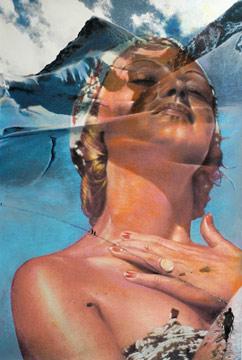Lawrence Gipe
dal 8/5/2003 al 28/6/2003
Segnalato da
8/5/2003
Lawrence Gipe
Joseph Helman, New York
Confluence. New drawings. In these recent series of drawings, Lawrence Gipe continues to explore issues of ideology, technology and aesthetics through the deconstruction of propaganda imagery, using a new process that he calls 'postDrawing'.

Confluence
Joseph Helman is pleased to present Confluence, an exhibition of new drawings
by Lawrence Gipe, and his ninth solo exhibition with the gallery.
In these recent series of drawings, Lawrence Gipe continues to explore issues
of ideology, technology and aesthetics through the deconstruction of
propaganda imagery, using a new process that he calls "postDrawing". Forgoing
the blank ground that is the starting point of conventional drawing, Gipe
begins with an image-laden surface that is prepared using various digital
media. The collaged images are digitally manipulated, enlarged and printed on
banner vinyl; Gipe then reworks the images with oil pastel and paint,
producing a hybridized work that exploits the flexibility of the computer
without sacrificing the touch of the artist.
The first series of drawings, titled Confluence, consists of a suite of seven
works. Within each drawing Gipe merges two contrasting images originating
from a single source, the photographer Dr. Paul Wolff, sometimes referred to
as "Hitler's second favorite photographer". Selecting images from Dr. Wolff's
banal, genre-based series "Bathing Beauties", which feature young blond women
in repose, and the equally cliched pictures of "Men at Work", Gipe
superimposes the contrasting images in order to subvert their encoded
banality. For example, in Confluence 2 (Die Jung Frau), a close-up shot of a
golden blond in a swimming cap and revealing suit is layered over the image
of a majestic mountainscape, upon which tiny figures appear to be trekking.
As the woman tilts her head back in a sort of reverie, her fingers languidly
trace a path on her neck that coincides with the arduous path of the distant
hikers, as though their struggle is transmuted into her longing. Through this
process of superimposing contradictory imagery, Gipe undermines the
totalitarian structure that inspired the original images, and in doing so he
creates a more provocative confluence of ideas.
The second series, Algorithm, consists of two large-scale banners that are
derived by merging many propaganda photographs from various countries during
the late 1930s. Sources include Soviet Stalin-era Five-Year Plan books, and
American, French and British photo annuals. Gipe's intentionally ambiguous
amalgam of images posits a "pan-propagandistic" aesthetic that is
disconcerting. In Algorithm 2 (One Hundred Children and a Goose), the
incessant repetition of smiling faces of children in a non-hierarchical,
flowing stream make no specific reference to any propagandistic agenda, but
does incite a very disturbingly eerie and false notion of joy.
Lawrence Gipe's work is collected by individuals and institutions all over
the world including the Los Angeles County Museum of Art and the Brooklyn
Museum. A traveling mid-career survey, "3 Five-Year Plans: Lawrence Gipe
1990-2005", is currently being organized by Marilyn Zeitlin at the University
Art Museum, Tempe, Arizona, with venues including the Contemporary Arts Forum
in Santa Barbara, CA. He recently completed a mural commission for the lobby
of the Federal Reserve Bank Headquarters in Atlanta, Georgia in a building
designed by Robert A.A. Stern. Currently, he teaches art studio (painting and
drawing) and the History of 20th Century Art at UCSB.
Articles and reviews of Gipe's works have appeared in Kunstforum, The New
York Times Magazine, Art and Antiques, L.A. Weekly, Architectural Digest,
Elle, The Los Angeles Times, Talk, ArtForum, ArtNews, Art in America, Flash
Art, Santa Barbara News Press, Vanity Fair, Village Voice, Bomb and many
others. A back catalogue of his works can be viewed on gipepictures.com.
Opening Reception: Friday 9 May, 6-8 pm
Image: Confluence 2 (Die Jung Frau), 2003
mixed media on banner vinyl
59 x 40 1/2 inches
For further information or images, please contact Peter Ryan at (212)
929-1545
Joseph Helman Gallery
601 West 26 Street
New York



